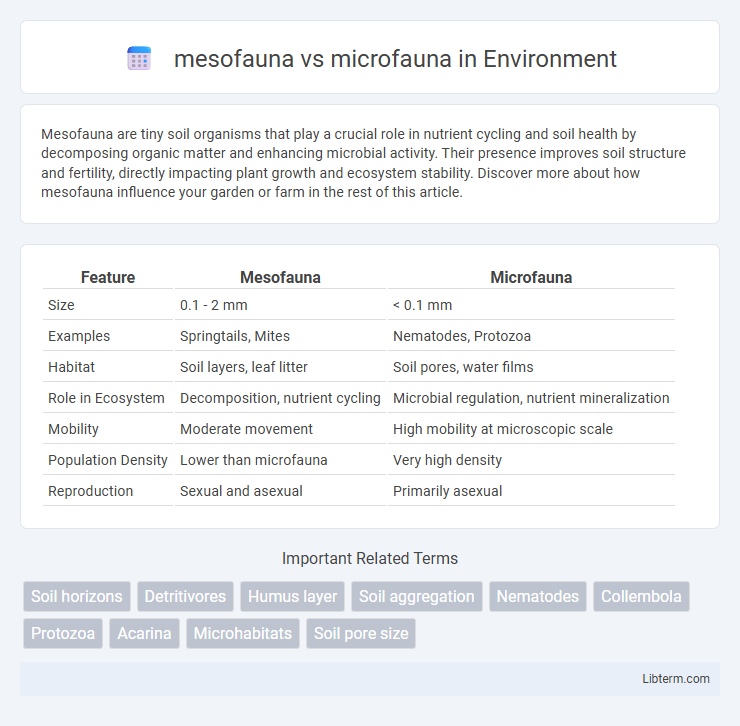Mesofauna are tiny soil organisms that play a crucial role in nutrient cycling and soil health by decomposing organic matter and enhancing microbial activity. Their presence improves soil structure and fertility, directly impacting plant growth and ecosystem stability. Discover more about how mesofauna influence your garden or farm in the rest of this article.
Table of Comparison
| Feature | Mesofauna | Microfauna |
|---|---|---|
| Size | 0.1 - 2 mm | < 0.1 mm |
| Examples | Springtails, Mites | Nematodes, Protozoa |
| Habitat | Soil layers, leaf litter | Soil pores, water films |
| Role in Ecosystem | Decomposition, nutrient cycling | Microbial regulation, nutrient mineralization |
| Mobility | Moderate movement | High mobility at microscopic scale |
| Population Density | Lower than microfauna | Very high density |
| Reproduction | Sexual and asexual | Primarily asexual |
Introduction to Mesofauna and Microfauna
Mesofauna are small soil organisms typically ranging from 0.1 to 2 millimeters, including mites and springtails, playing a crucial role in organic matter decomposition and nutrient cycling. Microfauna consist of microscopic organisms such as protozoa and nematodes, essential for regulating microbial populations and soil health. Both mesofauna and microfauna contribute significantly to soil ecosystem functioning, influencing soil structure and fertility.
Defining Mesofauna: Key Characteristics
Mesofauna are small soil organisms typically ranging from 0.1 to 2 millimeters in size, distinct from microfauna which are usually smaller than 0.1 millimeters. Key characteristics of mesofauna include their segmented bodies, presence of legs, and their role in soil structure and nutrient cycling by fragmenting organic matter. Common examples of mesofauna comprise mites, springtails, and nematodes, which contribute significantly to soil health and ecosystem functioning.
Understanding Microfauna: Main Features
Microfauna refers to microscopic organisms, typically ranging from 0.1 to 0.2 millimeters, that inhabit soil and aquatic environments, including protozoa, nematodes, and rotifers. These tiny creatures play crucial roles in nutrient cycling, organic matter decomposition, and maintaining soil structure and fertility. Unlike mesofauna, which are larger and often visible to the naked eye, microfauna exhibit remarkable adaptability to extreme conditions and rapid reproductive rates, making them essential for ecosystem resilience and functioning.
Habitat Differences: Where Mesofauna and Microfauna Live
Mesofauna predominantly inhabit soil layers, leaf litter, and decomposing organic matter, playing a crucial role in nutrient cycling in terrestrial ecosystems. Microfauna are commonly found in aquatic environments like freshwater and marine habitats, as well as in soil pores and plant roots where they contribute to microbial food webs. These habitat differences reflect their distinct ecological niches and adaptations, with mesofauna favoring larger, porous substrates and microfauna thriving in microscopic, often moisture-rich environments.
Size and Morphological Distinctions
Mesofauna are soil organisms ranging from 0.1 to 2 millimeters, typically including mites, springtails, and small insects characterized by segmented bodies and jointed appendages. Microfauna, such as nematodes, protozoa, and rotifers, are much smaller, generally less than 0.1 millimeters, and often possess simpler, less differentiated body structures without extensive segmentation. Size differences between mesofauna and microfauna correspond to distinct morphological features, with mesofauna exhibiting more complex anatomical adaptations for mobility and sensory functions in soil environments.
Ecological Roles in Soil and Ecosystems
Mesofauna, including mites and springtails, play critical roles in soil structure maintenance by fragmenting organic matter and enhancing microbial activity, which accelerates nutrient cycling. Microfauna such as nematodes and protozoa regulate bacterial and fungal populations, fostering a balanced soil microbiome essential for plant health. Both groups contribute to ecosystem resilience by promoting soil fertility and supporting plant growth through their interactions within the soil food web.
Methods for Identifying Mesofauna vs Microfauna
Mesofauna are commonly identified through soil sampling followed by methods such as Berlese-Tullgren funnels that extract organisms by gradually heating and drying the soil, while microfauna identification predominantly relies on microscopic examination of soil extracts or water samples using compound microscopes. Molecular techniques including DNA barcoding and environmental DNA (eDNA) analysis provide precise differentiation between mesofauna and microfauna by targeting specific genetic markers, enhancing detection accuracy in complex soil ecosystems. Morphological identification is more feasible for mesofauna due to their larger size (typically 0.1-2 mm), whereas microfauna, often smaller than 0.1 mm, require advanced imaging and molecular tools to overcome resolution limitations.
Importance in Environmental Monitoring and Research
Mesofauna and microfauna play crucial roles in environmental monitoring and research by acting as sensitive indicators of soil health, pollution levels, and ecosystem dynamics. Mesofauna, including mites and springtails, regulate organic matter decomposition and nutrient cycling, directly influencing soil fertility and structure. Microfauna, such as nematodes and protozoa, respond rapidly to environmental changes, providing precise data on contamination and biodiversity shifts in various habitats.
Common Examples of Mesofauna and Microfauna
Common examples of mesofauna include springtails (Collembola), mites (Acari), and small nematodes, which play vital roles in soil nutrient cycling and organic matter decomposition. Microfauna primarily consist of protozoa such as amoebae, ciliates, and flagellates, as well as rotifers, all essential for controlling bacterial populations and facilitating nutrient mineralization. Both mesofauna and microfauna collectively sustain soil health by contributing to microbial regulation and enhancing soil structure.
Summary: Comparing Mesofauna and Microfauna
Mesofauna typically ranges from 0.1 to 2 mm and includes organisms like mites and springtails, playing a crucial role in soil aeration and organic matter decomposition. Microfauna, usually under 0.1 mm, consists mainly of protozoa and nematodes, essential for nutrient cycling and regulating microbial populations. Both mesofauna and microfauna are integral to soil ecosystems, impacting biodiversity and soil health through complementary functions.
mesofauna Infographic

 libterm.com
libterm.com